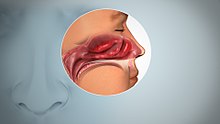User:Mr. Ibrahem/Loss of smell
| Mr. Ibrahem/Loss of smell | |
|---|---|
| Other names | Anosmia, smell blindness,[1] odor blindness |
 | |
| Inflamed nasal mucosa causing anosmia | |
| Pronunciation | |
| Specialty | Otorhinolaryngology |
| Symptoms | Loss of the ability to detect one or more odors[1][2] |
| Types | Partial, total[2] |
| Causes | Blockage of the noses, dysfunction of the neurons involved with smell[3] |
| Differential diagnosis | Hyposmia, parosmia, phantosmia[3] |
| Treatment | Depends on the underlying cause[3] |
| Frequency | 3 to 20% of those over 40 years[3][4] |
Loss of smell, technically known as anosmia, is the loss of the ability to detect one or more odors.[1][2] It may be temporary or permanent.[3] Some cases are present at birth while others are acquired later in life.[3] The inability to identify harmful smell can be dangerous and enjoyment of food can be affected.[3]
About 50 to 70% of cases are due to blockage of the nose, such as from inflammation or nasal polyps.[3] Other cases are due to dysfunction of the neurons involved with smell as a result of head injury, tumors, aging, toxins, or certain genetic condition.[3] It may also be a symptom of COVID-19, particularly early in infection.[5] Determining the underlying cause involves taking into account other symptoms and examination.[3] Some centers have the ability to do more detailed analysis.[3] It differs from hyposmia, which is a decreased sensitivity to some or all smells.[2]
Treatment depends on the underlying cause.[3] Steroid nose sprays may help with a number of causes of blockage of the nose.[3] Surgery may be an option for some sinus problems.[3] There is no specific treatment for cases due to dysfunction of neurons, though some cases may improve over days to years.[3]
About 3 to 20% of people age over 40 are affected.[3][4] The condition becomes more common with age, affecting about 40% of those over the age of 80.[3] One of the earliest documented cases of loss of smell following head trauma, was a case reported by Hughling Jackson in 1864 in London.[6]
References[edit]
- ^ a b c Coon D, Mitterer J (2014). "4. Sensation and perception". Introduction to Psychology: Gateways to Mind and Behavior. Boston: Cengage Learning. p. 136. ISBN 978-1-305-09187-0. LCCN 2014942026. Archived from the original on 2021-08-28. Retrieved 2020-12-02.
- ^ a b c d Jones, Nicholas (2010). "2. Making sense of symptoms". In Jones, Nicholas (ed.). Practical Rhinology. CRC Press. p. 24-25. ISBN 978-1-4441-0861-3. Archived from the original on 2021-08-28. Retrieved 2020-08-30.
- ^ a b c d e f g h i j k l m n o p q Li, Xi; Lui, Forshing (6 July 2020), "Anosmia", StatPearls, StatPearls Publishing, PMID 29489163, archived from the original on 29 September 2020, retrieved 1 December 2020
- ^ a b Boesveldt, Sanne; Postma, Elbrich M; Boak, Duncan; Welge-Luessen, Antje; Schöpf, Veronika; Mainland, Joel D; Martens, Jeffrey; Ngai, John; Duffy, Valerie B (September 2017). "Anosmia—A Clinical Review". Chemical Senses. 42 (7): 513–523. doi:10.1093/chemse/bjx025. ISSN 0379-864X. PMID 28531300. Archived from the original on 2020-12-24. Retrieved 2021-01-15.
- ^ Srivastava, Piyush; Gupta, Nidhi (2020). "3. Clinical manifestations of coronavirus disease". In Prabhakar, Hemanshu; Kapoor, Indu; Mahajan, Charu (eds.). Clinical Synopsis of COVID-19: Evolving and Challenging. Springer. p. 31-40. ISBN 9789811586804. Archived from the original on 2021-08-28. Retrieved 2021-01-16.
- ^ Costanzo, Richard M.; Ward, John D.; Young, Harold F. (2012). "20. Olfaction and Head Injury". In Michael J. Serby (ed.). Science of Olfaction. Karen L. Chobor. New York: Springer-Verlag. pp. 546–548. ISBN 978-1-4612-2836-3. Archived from the original on 2021-08-28. Retrieved 2021-01-15.
